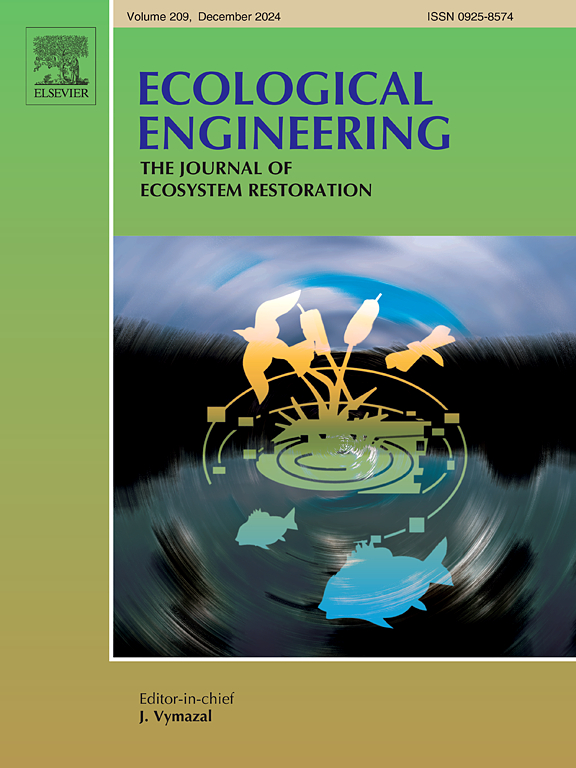古水化土壤的生物地球化学恢复及其在当代洪泛平原恢复中的作用
IF 4.1
2区 环境科学与生态学
Q1 ECOLOGY
引用次数: 0
摘要
溪流恢复已成为一种流行的管理方法,以减轻沉积物和营养物污染,并达到规定的水质指标。然而,这些恢复中有许多没有考虑到潜在的历史遗产影响(农业、筑坝、毁林等)的干扰前条件,以及如何利用它们进行更有效的环境恢复。在这里,我们评估了在恢复的洪泛平原表面上古代、以前埋藏的水化土壤的生物地球化学恢复及其提供反硝化生态系统服务的潜力。在马里兰州的Gramies Run修复现场,对残留的水化土壤和当代湿地土壤进行了为期三年的评估。孔隙水采样每月一次,土壤采样每6个月一次,评估总碳(C)和总氮(N)、硝态氮和铵态氮、氮处理速率(反硝化、净硝化和矿化)和活微生物量。含水土壤氧化释放无机氮,但溶解态氮浓度较低(≤1 mg/L)。水化土壤的反硝化速率在第1年较低(1 ~ 4 μg kg−1 h−1),但在第3年缓慢升高(10 ~ 47 μg kg−1 h−1)。我们的观察表明,残留的水化土壤将需要三年或更长时间才能提供恢复生态系统服务,如改善反硝化作用,并且必须考虑恢复水质的缓慢收益。我们还建议将含水土壤保留在原位,不受干扰,在那里它们处于原始海拔和土壤湿度条件,以便更快地恢复。本文章由计算机程序翻译,如有差异,请以英文原文为准。
Biogeochemical recovery and role of ancient hydric soils in contemporary floodplain restorations
Stream restoration has become a popular management practice to mitigate sediment and nutrient pollution and to meet regulatory water quality targets. Many of these restorations, however, fail to account for the pre-disturbance conditions underlying historical legacy impacts (farming, damming, deforestation, etc.) and how they can be leveraged for more environmentally effective restorations. Here, we assessed the biogeochemical recovery of ancient, previously buried, hydric soil on a restored floodplain surface and its potential for providing denitrification ecosystem services. Relict hydric soil along with contemporary wetland soils were evaluated for three years at the Gramies Run restoration site in Maryland. Porewater sampling was conducted monthly, and soil samples were collected every six months, both of which were evaluated for total carbon (C) and nitrogen (N), nitrate and ammonium-N, N process rates (denitrification and net nitrification and mineralization) and living microbial biomass. Oxidation of hydric soils released inorganic N, but the dissolved N concentrations were low (≤ 1 mg/L). Denitrification rates in the hydric soil were low in year 1 (1–4 μg kg−1 h−1) but slowly increased to higher values by year 3 (10–47 μg kg−1 h−1). Our observations suggest that relict hydric soils will require three or more years to provide restoration ecosystem services like improved denitrification and slow gains must be considered in water quality expectations from restoration. We also recommend that hydric soils be retained in-situ, undisturbed, where they are at their original elevations and soil moisture conditions for quicker recovery.
求助全文
通过发布文献求助,成功后即可免费获取论文全文。
去求助
来源期刊

Ecological Engineering
环境科学-工程:环境
CiteScore
8.00
自引率
5.30%
发文量
293
审稿时长
57 days
期刊介绍:
Ecological engineering has been defined as the design of ecosystems for the mutual benefit of humans and nature. The journal is meant for ecologists who, because of their research interests or occupation, are involved in designing, monitoring, or restoring ecosystems, and can serve as a bridge between ecologists and engineers.
Specific topics covered in the journal include: habitat reconstruction; ecotechnology; synthetic ecology; bioengineering; restoration ecology; ecology conservation; ecosystem rehabilitation; stream and river restoration; reclamation ecology; non-renewable resource conservation. Descriptions of specific applications of ecological engineering are acceptable only when situated within context of adding novelty to current research and emphasizing ecosystem restoration. We do not accept purely descriptive reports on ecosystem structures (such as vegetation surveys), purely physical assessment of materials that can be used for ecological restoration, small-model studies carried out in the laboratory or greenhouse with artificial (waste)water or crop studies, or case studies on conventional wastewater treatment and eutrophication that do not offer an ecosystem restoration approach within the paper.
 求助内容:
求助内容: 应助结果提醒方式:
应助结果提醒方式:


